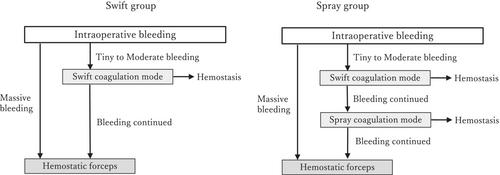Spray coagulation reduces the use of hemostatic forceps for intraoperative bleeding in gastric endoscopic submucosal dissection
Abstract
Aims
During intraoperative bleeding in endoscopic submucosal dissection (ESD), switching to spray coagulation may be beneficial compared with the continuous use of swift coagulation and can reduce the need for hemostatic forceps. We retrospectively assessed the effectiveness of spray modes on intraoperative bleeding during gastric ESD.
Methods and Results
A total of 316 bleeding events (156 in the Swift group and 160 in the Spray group) were consecutively recorded. In the Swift group, hemostasis was performed using the swift mode with a retracted tip of the needle-type knife, followed by the hemostatic forceps. In the Spray group, bleeding was treated in a stepwise manner: the swift mode, the spray mode, and the hemostatic forceps. All bleeding events were assigned to one of two groups by an endoscopist who retrospectively reviewed the videos. We compared the use of hemostatic forceps, the total hemostatic time, and the cumulative hemostasis rate between the two groups.
The use of hemostatic forceps was significantly lower in the Spray group than in the Swift group (32.7% vs. 13.8%, P < 0.001). There was no significant difference in the total hemostatic time (Swift group, 20 s.; Spray group, 16 s.; P = 0.42), whereas the cumulative hemostasis rate with the knife was significantly higher in the Spray group (P = 0.007).
Conclusion
The results suggested that spray coagulation from the tip of the needle-type knife could reduce the use of hemostatic forceps. In gastric ESD, spray coagulation may facilitate the hemostasis of intraoperative bleeding.


 求助内容:
求助内容: 应助结果提醒方式:
应助结果提醒方式:


